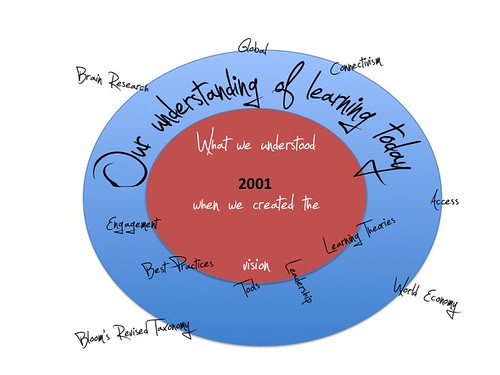
Systematic Change: Part 1
(What follows is the thinking of many people that I have the pleasure to work with every day. It is my hope that I can put into words, for myself, how we are trying to bring systematic change to our school in hopes that you might be able to use a piece of it to bring change within your organization as well)
Systematic change does not come easy. There are many factors, people, and a history to overcome. Yet educational organizations find themselves struggling with the changes needed to stay relevant in a connected, digital world.
There are many ways to approach systematic change, yet systematic change begins and ends with a vision. A vision of what your organization hopes to aspire to some day. A vision is never really meant to be accomplished, but is instead a guiding light for an organization. A statement that allows the organization and it’s employees to focus on the task at hand.
In the past we felt the need to have different visions. A school vision, a technology vision, a vision for learning. We have different visions to drive us forward in different areas.
When we get right down to it, there really only is one vision. One guiding light that hopefully everyone within the organization can hang their hat on. So how do we make sure our visions are relevant in today’s fast pace, digital world?
I’ve spend the last couple of days looking over different school visions. It’s not that school visions are bad, but instead what we need to do is expand our thinking on what they mean in today’s world. There are many school visions that were created at just the wrong time. Right when the world was changing, schools were revisiting their school vision. Many school visions I found were created/crafted in the late 1990s or Early 2000s. What we know has changed in the past eight years. We’re not talking little change, we’re talking significant change in what we know about learning, the brain, knowledge, etc. What we need to do is many cases is re-exam our visions and understand them in a new context.
Examples from vision statements (takin from schools I have worked at or will be working with):
The gift of cross-cultural understanding
In 2003 having an understanding of other cultures meant, in many cases, studying it in a book, maybe watching a video. Google Earth (2004), YouTube (2005), Skype (2003) weren’t created. Our understanding of what it means to be cross-cultural and the tools available to help students and teachers reach that vision in new meaningful ways has changed. It’s still important…but the context of what it means to be cross-cultural has changed.
Effective communicators who do so through clear and concise written and
spoken language, relevant visuals, accurate numeracy, active listening,
critical reading, appreciation of humor and artistic expression.
This isn’t a bad vision statment. But has the school as an organization looked at what this means in a digitally connected world. What does it mean to communicate effectivley in a world of SMS, IM, Skype, E-mail, Blogs, Wikis, Social-Networks? What does concise writing look like in an e-mail vs. a report? How do you read critically in a book vs the web? Artistic expression: YouTube? Flickr?
Our mission is to encourage students to be independent, lifelong
learners who strive for excellence and become responsible stewards of
our global society and natural environment, achieved within a
supportive community that values diversity.
What does this mean in a digitally connected world?
Students should have a mastery of the core concepts and factual
information needed to function effectively in our current and future
society.
What are teh core concepts for today? What factual information is needed?
As you past that vision statement today that I’m sure is hanging in your own office or hallway. Stop and have a read and then think do this apply to today’s learning landscape? In some cases it might be time to revisit the vision. In other cases it might be as simple as having conversations to expand the context of what the vision means in today’s world.
On Thursday during the Shifting Our Schools Podcast we’ll be looking at the Essential Question: Where do you start the shift?
In Part 2 of this mini series we’ll look at ways to start the conversation.








Your blog has some real substance. I think the examples that you included are great for the point that you are making. I just have one question. In Episode 13 of the shifting process, you mentioned transition and time. Technology, information, everything is changing and growing so fast. In order to create a new vision, if a school needs time, how much time should be allotted for that vision/change to set in motion? I guess I had never really looked into the mission of any schools before, I am really glad that you brought that to my attention. It is something that I have long overlooked in comparison the growth of ‘today’.
[…] and Jeff put a few thoughts in posts on the […]
Teaching children vision and thinking skills is more important than any other skill, in my opinion. Once someone has vision and can put that vision into a constructed plan, then can achieve anything.